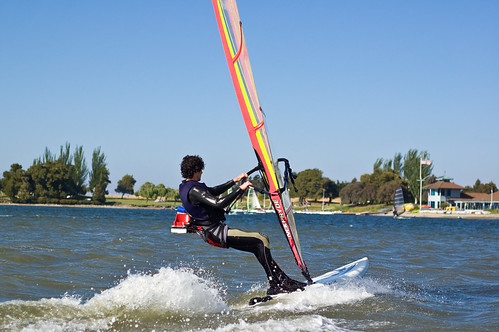
With ever advancing autofocus technology out there, a whole new string of buzzwords have come about: single servo, group dynamic, 3-D motion tracking, etc. However you want to call it, it’s job is to help you get your subject in focus and keep it there using a number of sensor points, ranging from 3 (boo on Nikon D40) to 51 (yay for Nikon D300, D3). With autofocus doing all the work, it’s hard to believe there was a time where people had to manually focus. Especially with sports, where every split second counts. I got a taste of that this past weekend, and it was definitely fun.
It was a beautiful Sunday afternoon, so we rented a pedal-boat from Shoreline Park in Mountain View, CA. I was a bit hesitant to bring my D40 and a 50mm f/2.0 Pre-AI lens — I had an experience once where our canoe flipped over and all our electronics were soaking in water for about 20 minutes. I didn’t want the same fate to happen to my beloved SLR. But pedal-boats are very heavy and sturdy, so chance of that happening again was slim. Once on the boat, and after a bit of bumper boats (think bumper cars but with boats), I started to look for subjects to shoot. The scenery was meh — sun was bright and high, no clouds, lots of reflections from the lake (no polarizer handy). Basically, a very low contrast, dull scene.
Then the windsurfers flew past us, and that got my camera’s attention. On land, they are too far to photograph, but out in the lake, they are practically right next to you. The perfect opportunity to try out some action shots!
So I had my camera set up for:
- ISO 200 – the lowest it can go
- f/2.8 – for some shallow depth of field, but not too shallow to make focusing easier
- 1/3200s – turns out that’s the shutter speed I needed to get the correct exposure based on my aperture. More than enough to stop the action
- Auto white balance – I shoot in raw, so WB not an issue
And that’s it. Exposure’s the easy part. Those settings never changed for the entire shoot. In retrospect, I might’ve used a longer telephoto, like the 100mm or 135mm Series E. The background just wasn’t blurred enough for my taste. But at f/2.8, the 50mm is sharper than my telephotos wide open, so I can’t complain there.
In the technical aspects of photography, my weakest point has always been focusing. It takes me several seconds before I am satisfied with the focus, and people always get impatient with me for that reason (which is why I hate doing portraits). So imagine having to focus manually with a high speed subject. It was quite the adrenaline rush.
We pedaled to a certain spot and waited for the windsurfers to come to us. Many were gracious enough to pose for me as they flew by, which was great. I panned on each subject, adjusting focus until the confirmation dot lights up. Then I fire away, holding down that shutter as long as it can go, accounting for focus as necessary. Spray n’ pray…
You can see how fast the shutter count racks up when using this technique. Not very elegant and not much thought on composition, but if it gets the shot, that’s good enough for me. Well, going through post-processing, I found a prevalent error on most of the shots — I was back focusing. Hmm, a number of possibilities could’ve happened:
- The AF confirmation dot was fooled into locking on to the background instead of the subject.
- My manual focusing is too slow, so by the time I dialed in the focus ring, the subject distance had already changed.
Not sure which issue it is — could be a combination of both. Anyway, out of the 90 or so shots I took, only 3 were usable. Ouch. That’s about a 3% keep rate, pretty bad even for my standards. Nevertheless, it’s better than having no pictures at all! All in all, it was a lot of fun. Shooting action and sports is very different than landscapes and nature photography, but it’s also very exciting. It’s definitely an ride I want to go on again!

 Posts
Posts